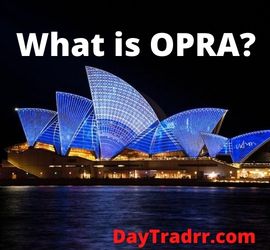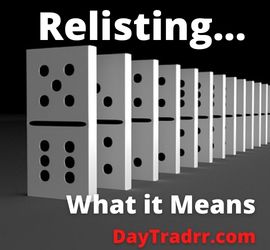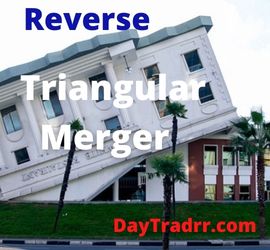What Is the Options Price Reporting Authority (OPRA)?
 The Options Price Reporting Authority (OPRA) is a group of members from participating securities exchanges tasked with delivering last-sale option quotes and information from the exchanges. OPRA controls the process through which market participants share, aggregate, and distribute market data as a national market system plan. Trades and quotations are the principal data feed provided by OPRA. Trade data is comprised of the latest sale reports for completed securities transactions. Quotations are comprised of the latest bids and offers for options.
The Options Price Reporting Authority (OPRA) is a group of members from participating securities exchanges tasked with delivering last-sale option quotes and information from the exchanges. OPRA controls the process through which market participants share, aggregate, and distribute market data as a national market system plan. Trades and quotations are the principal data feed provided by OPRA. Trade data is comprised of the latest sale reports for completed securities transactions. Quotations are comprised of the latest bids and offers for options.
In the United States, OPRA is the key securities information processor for market information created by the trading of securities options. The cornerstone of the information disseminated by OPRA is the latest sales data and quotations. However, OPRA also disseminates certain additional sorts of information. For example, the number of options contracts traded, open interest, end-of-day summaries, and certain types of administrative communications.
Options Price Reporting Authority (OPRA) Contributors
The Options Price Reporting Authority (OPRA) distributes its services into two categories. One is a basic service for all options excluding foreign currency derivatives. The other is an FCO service for information on foreign currency options. The Boston Options Exchange (BOX), Cboe Options Exchange, International Securities Exchange (ISE), Philadelphia Stock Exchange (PHLX), Miami International Securities Exchange, NYSE Arca, NYSE American, and Nasdaq BX Options are all part of the organization. OPRA aggregates the quotations from each exchange to provide a national best bid and offer (NBBO) quote.
In a more informal sense, the Options Price Reporting Authority is an industry-led partnership. It promotes the timely and accurate compilation and publication of market data. Listed options and associated securities, in particular, are among the more exotic financial instruments. Behind the scenes, the activities and data given by the Options Price Reporting Authority contribute significantly to market liquidity and other factors that drive market efficiency. Capital markets would be less developed without the data and information given by OPRA. The result would be a higher cost of capital for savers and borrowers.
Options Price Reporting Authority (OPRA) Clients
OPRA classifies recipients of options information as either “Vendors” or as “Subscribers.”
A Vendor is a person or institution that has the contractual permission to retransmit options information externally. That is, to people outside of its own company. Each vendor must engage in a “Vendor Agreement” with OPRA directly. The Vendor Agreement outlines the Vendor’s rights to obtain information and redistribute it to its consumers. For example, broker-dealers, institutional investors, and individual investors. OPRA data access and use fees are paid by vendors.
A Subscriber is an entity or a person who has the right to use options information only internally. That is, inside the Subscriber’s organization if the Subscriber is a company. Or, only with the Subscriber himself or herself if the Subscriber is a human being. A broker-dealer is both a Vendor and a Subscriber if it uses information internally and distributes it to others. For example, its brokerage clients. Subscribers are classified by OPRA as either “Professional Subscribers” or “Nonprofessional Subscribers.”
Professional and Nonprofessional
- A Nonprofessional Subscriber is essentially an individual person who will use the options information only in connection with individual investment activities. Not in connection with any trade or business activities, and not for the benefit of any other person or entity. Also, a person who is not employed in the securities industry or the commodity futures industry, or by a bank, an insurance company, or an affiliate of either. In other words, they are not to perform functions related to securities or commodity futures investment, or by a bank, an insurance company, or an affiliate of either to perform functions related to securities or commodity futures investment. If a person qualifies as a Nonprofessional Subscriber, the person enters into a contract with a Vendor to get options information. In turn, the Vendor pays OPRA’s charge for the Nonprofessional Subscriber’s options information receipt.
- A Professional Subscriber may enter into a direct contract with OPRA to get options information and pay fees directly to OPRA. If Professional Subscribers contracts directly with OPRA, the fees it pays can be device-based. For example, depending on the number of devices the Professional Subscriber owns that may receive options information. Conversely, fees can be based on the number of registered representatives the Professional Subscriber owns. OPRA refers to professional subscription fees dependent on the number of registered representatives as “enterprise-rate” payments.
How to Read Options Price Reporting Authority (OPRA) Quotes
Options have their own language, and when you first start trading options, the information might be daunting. When looking at an options quotation, it may seem to be rows of incomprehensible numbers at first. However, options quotes, also known as options chains, give significant information about the security now and where it may go in the future. Options are not available for all public stocks, but for those that do, the information is displayed in real-time and in a consistent sequence. Here’s a summary of a common options symbol provided by OPRA.
OPRA Example
Options symbols or the OPRA contain six different bits of information. For example:
MSFT220204C23550 (Microsoft $235.50 call options that are due to expire on Feb. 04, 2022.)
- OPRA Root: Options Root (MSFT) – the ticker symbol of the underlying security, typically between one and six letters.
- Expiration Year: (22) – two characters that tell you the year in which the option expires. In our example, the year is 2022.
- Expiration Month: (02) – the next two characters give the month the option expires. In this example, the month is the second month of the calendar year or February.
- Expiration Day: (04) – the next two characters indicate the day on which the option expires. For this example, the 4th.
- Type of Option: (C) – indicates if the option is either a call or put option. The above example is a call. A put option would be indicated by a (P).
- Strike Price: (235.5) – the rest of the options symbol is defined by the strike price of the option. In this example, it is the $235.50 call options that are due to expire on Feb. 04, 2022.
Up Next: What Is a Stock Relisting Vs Delisting?
 Relisting and delisting are procedures for adding and removing securities from a stock exchange. Companies may be delisted willingly or as a result of regulatory issues. A relisting is the same as a fresh listing or an initial public offering (IPO).
Relisting and delisting are procedures for adding and removing securities from a stock exchange. Companies may be delisted willingly or as a result of regulatory issues. A relisting is the same as a fresh listing or an initial public offering (IPO).
A firm that has been relisted is one that has returned to the public market after a time of not being quoted on an exchange. Companies may delist for one of two reasons. Either they fail to meet the exchange’s listing standards, or they voluntarily withdraw their shares from the market. For example, Dell delisted voluntarily from the Nasdaq Exchange in 2013. Then, Dell relisted on the NYSE in 2018.




